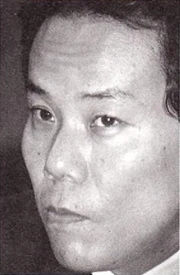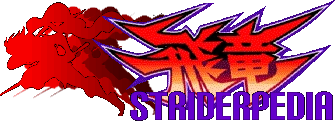No edit summary |
mNo edit summary |
||
| Line 1: | Line 1: | ||
{{Stub}} |
{{Stub}} |
||
{{Template:Infobox |
{{Template:Infobox |
||
| − | |Box title = <center><b> |
+ | |Box title = <center><b>Sakai, Akio</b><br>{{J|坂井昭夫|}}</center> |
|image = File:NG_Akio_Sakai_1996.png |
|image = File:NG_Akio_Sakai_1996.png |
||
|imagewidth = 180px |
|imagewidth = 180px |
||
| Line 8: | Line 8: | ||
|Row 1 info = Head of department, producer |
|Row 1 info = Head of department, producer |
||
}} |
}} |
||
| − | '''Akio Sakai''' ({{J|坂井昭夫}}) was an executive at Capcom during the late '80s and most of the '90s. He's not to be confused with the Akio Sakai who founded [[wikipedia:Imagin_(studio)|Imagin]], whose name is written with different kanji ({{J|酒井明雄}}).<ref>"[http://imagin.mobi/会社案内/会社概要/ Summary]" (Japanese). ''Imagin'' official site. Accessed June 1, 2016</ref> |
+ | '''Akio Sakai''' ({{J|坂井昭夫|}}) was an executive at [[Capcom]] during the late '80s and most of the '90s. He's not to be confused with the Akio Sakai who founded [[wikipedia:Imagin_(studio)|Imagin]], whose name is written with different kanji ({{J|酒井明雄|}}).<ref>"[http://imagin.mobi/会社案内/会社概要/ Summary]" (Japanese). ''Imagin'' official site. Accessed June 1, 2016</ref> |
| − | Little is known about Akio Sakai's career. He joined Capcom at some point in the latter half of the '80s as Head of Development. Until that point Capcom worked exclusively with proposals coming from its internal teams, so Sakai suggested to start working on projects with other companies.<ref name=LSCM>Scion; Dire 51 ( |
+ | Little is known about Akio Sakai's career. He joined Capcom at some point in the latter half of the '80s as Head of Development. Until that point Capcom worked exclusively with proposals coming from its internal teams, so Sakai suggested to start working on projects with other companies.<ref name=LSCM>Scion; Dire 51 (April 24, 2010). [http://lscmainframe.kontek.net/features/kyotsui.html "Interview with Kouichi "Isuke" Yotsui".] LSCM 4.0. Translated by Gaijin Punch. Accessed June 1, 2016.</ref> |
| − | One such project Sakai was able to secure was a deal with artist circle [[Moto Kikaku]] to start a [[Strider (CPS-1)/Development|three-way project as a test to run a serialized manga and game at the same time]]<ref name=LSCM/>, producing [[Strider (CPS-1)|an Arcade]] and [[Strider (NES)|NES game]] to accompany [[Strider Hiryu (Manga)|a manga produced by Moto Kikaku]], all under the name ''Strider Hiryū''. He and producer Tokuro Fujiwara would also visit the three project heads during their stay at the Shinjuku Hilton hotel from time to time and assist them with creating the story, world setting and [[Hiryu|main character]].<ref name=LSCM/> |
+ | One such project Sakai was able to secure was a deal with artist circle [[Moto Kikaku]] to start a [[Strider (CPS-1)/Development|three-way project as a test to run a serialized manga and game at the same time]]<ref name=LSCM/>, producing [[Strider (CPS-1)|an Arcade]] and [[Strider (NES)|NES game]] to accompany [[Strider Hiryu (Manga)|a manga produced by Moto Kikaku]], all under the name ''Strider Hiryū''. He and producer [[Tokuro Fujiwara]] would also visit the three project heads during their stay at the Shinjuku Hilton hotel from time to time and assist them with creating the story, world setting and [[Hiryu|main character]].<ref name=LSCM/> |
There were other similar projects being developed around the same time as ''Strider'' which he may have been involved with, such as the 1989 Arcade and NES adaptations of ''[[wikipedia:Willow_(film)|Willow]]'' (a western live-action film), the 1990 Arcade and NES adaptations of ''[[wikipedia:Little_Nemo:_Adventures_in_Slumberland|Little Nemo]]'' (an American/Japanese animated film) and the 1989 Japanese live-action film and NES project ''[[wikipedia:Sweet_Home_(film)|Sweet Home]]''. |
There were other similar projects being developed around the same time as ''Strider'' which he may have been involved with, such as the 1989 Arcade and NES adaptations of ''[[wikipedia:Willow_(film)|Willow]]'' (a western live-action film), the 1990 Arcade and NES adaptations of ''[[wikipedia:Little_Nemo:_Adventures_in_Slumberland|Little Nemo]]'' (an American/Japanese animated film) and the 1989 Japanese live-action film and NES project ''[[wikipedia:Sweet_Home_(film)|Sweet Home]]''. |
||
| − | By 1996 Akio Sakai was still with Capcom working as head of the "Consumer Software/Sales Division" |
+ | By 1996 Akio Sakai was still with Capcom working as head of the "Consumer Software/Sales Division" overseeing the porting and localization of several of the company's Arcade games<ref>Staff (May 1996). "[https://ia902601.us.archive.org/BookReader/BookReaderImages.php?zip=/27/items/Next-Generation-1996-05/Next%20Generation%201996-05_jp2.zip&file=Next%20Generation%201996-05_jp2/Next%20Generation%201996-05_0072.jp2&scale=2&rotate=0 Capcom]". ''Next Generation'' (17). Pg. 67-69</ref><ref>Staff (February 1996). "[https://ia600306.us.archive.org/BookReader/BookReaderImages.php?zip=/28/items/mean-machines-sega-magazine-40/MMSega_40_Feb_1996_jp2.zip&file=MMSega_40_Feb_1996_jp2/MMSega_40_Feb_1996_0017.jp2&scale=4&rotate=0 Cover Story: Vampire Hunter]" (English). ''Mean Machines Sega'' (40). Pg. 18-21</ref>. He was also the youngest member on the board at the time. During this time he also served as general/associate producer in many of Capcom's licensed film and television shows, both Japanese and American in origin.<ref>"[http://www.imdb.com/name/nm0756991/?ref_=ttfc_fc_cr6 Akio Sakai]". ''imdb.com''. Accessed June 1, 2016</ref> |
| − | Around the end of the 90's Sakai left Capcom and pursued other ventures, most notably being producer in Square's 2001 CGI film [[wikipedia:Final_Fantasy:_The_Spirits_Within|''Final Fantasy: The Spirits Within'']]<ref name=LSCM/> and |
+ | Around the end of the 90's Sakai left Capcom and pursued other ventures, most notably being producer in Square's 2001 CGI film [[wikipedia:Final_Fantasy:_The_Spirits_Within|''Final Fantasy: The Spirits Within'']]<ref name=LSCM/> and the head of the Hawaii office at Square. He has since passed away.<ref name=LSCM/> |
==References== |
==References== |
||
Revision as of 04:44, 26 May 2020
坂井昭夫 | |
|---|---|
 Akio Sakai, circa 1996 | |
|
Occupation: |
Head of department, producer |
Akio Sakai (坂井昭夫) was an executive at Capcom during the late '80s and most of the '90s. He's not to be confused with the Akio Sakai who founded Imagin, whose name is written with different kanji (酒井明雄).[1]
Little is known about Akio Sakai's career. He joined Capcom at some point in the latter half of the '80s as Head of Development. Until that point Capcom worked exclusively with proposals coming from its internal teams, so Sakai suggested to start working on projects with other companies.[2]
One such project Sakai was able to secure was a deal with artist circle Moto Kikaku to start a three-way project as a test to run a serialized manga and game at the same time[2], producing an Arcade and NES game to accompany a manga produced by Moto Kikaku, all under the name Strider Hiryū. He and producer Tokuro Fujiwara would also visit the three project heads during their stay at the Shinjuku Hilton hotel from time to time and assist them with creating the story, world setting and main character.[2]
There were other similar projects being developed around the same time as Strider which he may have been involved with, such as the 1989 Arcade and NES adaptations of Willow (a western live-action film), the 1990 Arcade and NES adaptations of Little Nemo (an American/Japanese animated film) and the 1989 Japanese live-action film and NES project Sweet Home.
By 1996 Akio Sakai was still with Capcom working as head of the "Consumer Software/Sales Division" overseeing the porting and localization of several of the company's Arcade games[3][4]. He was also the youngest member on the board at the time. During this time he also served as general/associate producer in many of Capcom's licensed film and television shows, both Japanese and American in origin.[5]
Around the end of the 90's Sakai left Capcom and pursued other ventures, most notably being producer in Square's 2001 CGI film Final Fantasy: The Spirits Within[2] and the head of the Hawaii office at Square. He has since passed away.[2]
References
- ↑ "Summary" (Japanese). Imagin official site. Accessed June 1, 2016
- ↑ 2.0 2.1 2.2 2.3 2.4 Scion; Dire 51 (April 24, 2010). "Interview with Kouichi "Isuke" Yotsui". LSCM 4.0. Translated by Gaijin Punch. Accessed June 1, 2016.
- ↑ Staff (May 1996). "Capcom". Next Generation (17). Pg. 67-69
- ↑ Staff (February 1996). "Cover Story: Vampire Hunter" (English). Mean Machines Sega (40). Pg. 18-21
- ↑ "Akio Sakai". imdb.com. Accessed June 1, 2016
